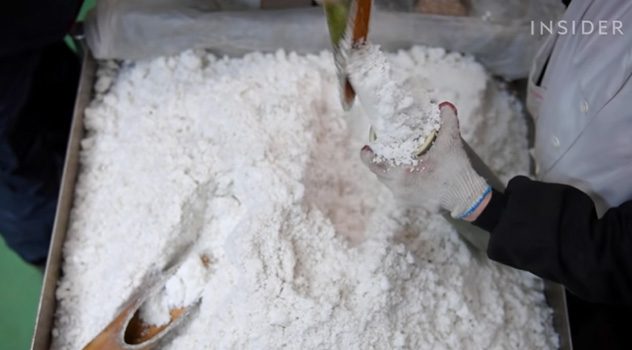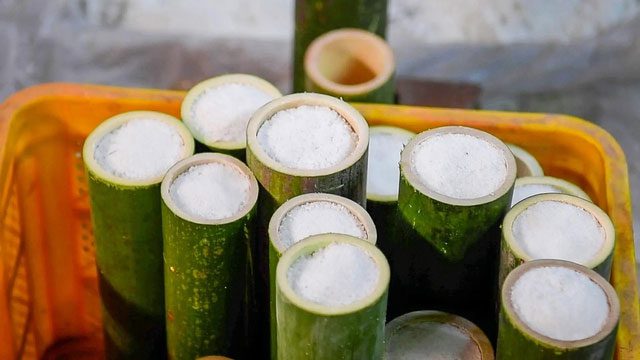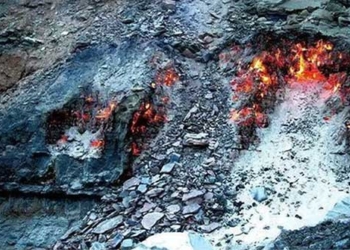Korean bamboo salt is a luxury product that can cost over $100 for a 240g jar. The price is primarily determined by the entirely handmade process that requires a large workforce.
Salt is an essential spice in cooking and is typically very inexpensive. In the market, common white salts are sold at traditional markets, stores, or supermarkets for just a few thousand dong per kilogram.
If you think that Himalayan pink salt is the most expensive type of salt, you might not have heard of Korean bamboo salt (jugyeom), known as the most expensive salt in the world, having undergone nine rounds of roasting at temperatures over 800°C.

All stages of making bamboo salt are done by hand.
This unique salt is made by filling bamboo tubes with seawater collected from the western coast of Korea and shaking them nine times in a traditional kiln. This is a complex process that takes a month to complete.
Since every step is done by hand, it is no surprise that Korean bamboo salt can be sold for over $100 per jar.
Bamboo salt has existed for about 1,000 years in Korea, but the nine-times roasted version has only been around since the 20th century. Previously, salt was only roasted two or three times, but it was later discovered that multiple roasting helped the bamboo essence penetrate the salt more effectively and also removed many impurities, resulting in one of the purest salts on the planet. This salt was originally used in traditional Korean medicine, assisting in the prevention and treatment of various ailments. Additionally, Korean bamboo salt is also used in everyday cooking as a seasoning.
The process of making bamboo salt begins by cutting three-year-old bamboo into cylindrical shapes, leaving one end open to fill with seawater. The other end is then sealed with a special ceramic clay. Afterward, these bamboo tubes are placed in a kiln fueled by pine wood, heated to nearly the melting point of salt (800°C).
As the bamboo heats up, oils from the wood are released and absorbed into the salt, believed to impart a rich aroma and health-enhancing properties.
After 14-15 hours, the bamboo tubes turn to ash, leaving only salt crystals, which are then crushed and packed into bamboo tubes once again. This process is repeated eight times in total.
The ninth roasting process differs slightly, as the salt is now heated to around 1,000°C, causing the salt and bamboo to completely melt. This mixture is then poured into molds and allowed to solidify for several days. The salt, resembling rock, is then manually broken apart, packaged, and sold.
The final stage of this process is the most challenging, as a mistake could waste 30-50 days of hard work.

Koreans fill bamboo tubes with seawater and roast them nine times to create bamboo salt. (Photo: BI)
Korean bamboo salt is considered the purest roasted bamboo salt in the world and also has the highest mineral content. Some praise it for its complex flavor, likening it to egg yolk, attributed to the oils from the bamboo, and many believe it has healing properties.
Although scientific studies have yet to prove the health benefits of consuming bamboo salt, supporters of this luxury product claim it can aid digestion, improve oral health, reduce inflammation, and some even suggest it has anti-cancer effects.
Whether bamboo salt is truly better or tastes better than regular table salt remains a topic of debate, but its high price is undeniable. With prices exceeding $100 for a 240g jar, it is regarded as the most expensive salt in the world.
- Why is Himalayan Pink Salt 20 Times More Expensive Than Regular Salt?
- The Buddha Statue on the Mountain Side of Vietnam: Why Does it Surpass the Giant Buddha of Leshan to Break the World Record?
- 13 Common Questions About the World That Everyone Confidently Thinks They Know, But Are Actually Completely Misconceptions
- The Mystery of Ancient Pyramids in China: “Burial Mounds” with Unique Shapes or Hidden?





















































